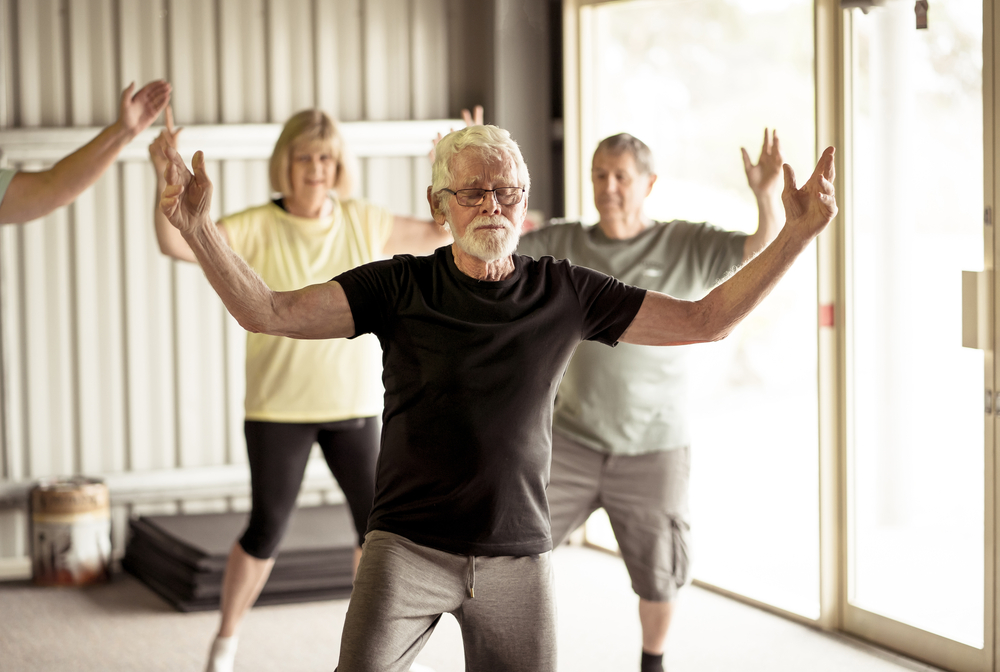
Studies show there are many health conditions that Tai Chi can improve. We often describe Tai chi as “meditation in motion” . However we might well call it medication in motion. Harvard Medical School says “research is increasingly building a compelling case for tai chi to be used alongside standard medical treatment.” This might be to address a disease itself or its primary symptoms. Or it might be for the prevention of certain conditions. In addition, it can be use in rehabilitation to improve a patient’s functioning and quality of life.
According to Traditional Chinese Medicine, ancient “healers, and modern-day doctors, inadequate blood circulation and stiff joints are two main reasons for recurring pain in the body. Both Tai Chi and Qigong improve blood circulation and heal stiff muscles which reduces pain and improves well-being and quality of life.
Tai Chi is slow and gentle and doesn’t leave you breathless. However it does address the key components of fitness — muscle strength, flexibility, balance, and, to a lesser degree, aerobic conditioning.
Research into health conditions
Research shows that regular practice of Tai Chi can improve many health conditions. For example, there are benefits for hip pain and chronic pain. In addition, a recent study by Texas Tech University investigated the neurobiological mechanisms in post menopausal women with knee osteoarthritis. It observed significant changes in response to Tai Chi exercise. They included reduced knee pain and stiffness. The study also suggests that Tai Chi also has an important role in improving brain function.
There was another study into health conditions by the University of Hong Kong, The Chinese University of Hong Kong; Chinese Academy of Sciences; and UCLA. The researchers found that Tai Chi can be an effective intervention to improve waist circumference and blood pressure in the elderly.
There is evidence that mind-body techniques such as Tai Chi help to improve mobility and balance. They also address musculoskeletal pain. For example, research conducted in individuals with Parkinson’s disease. The study found that verbal instructions, including imagery and visualization, can impact postural control. This means they are effectively therapeutic modalities which could be used to enhance conventional rehabilitation interventions.
Chronic Fatigue Syndrome
Chronic Fatigue Syndrome, otherwise known as ME (Myalgic Encephalomyelitis) is an enigmatic disease with no known cure. It varies in intensity but the symptoms include fatigue that isn’t refreshed with sleep. In addition sufferers may experience post-exercise malaise and anything from excruciating joint pain and severe headaches to light and sound intolerance.
A Tai Chi practitioner in the United States has had some positive results in using Tai Chi to help with the symptoms of ME. The essence of Lloyd Kelly’s practice is that it is undemanding. However it has a beneficial effect on circulation, oxygen uptake, flexibility and mobility. It makes even the extremely sick feel a little better; they can do something positive that won’t land them in bed for days.
The Movement In Mind approach
At Movement In Mind we agree with Lloyd Kelly’s “no pain, no pain” concept. Our Tai Chi for Better Health encourage gentle movement with no strain on the body. Working at around 70% of your comfort level is definitely the best approach.
Our wellbeing programme includes Tai Chi for Health sets designed to help specifically with Osteoporosis, Arthritis and Diabetes. However research shows they will benefit a much wider range of health conditions.
